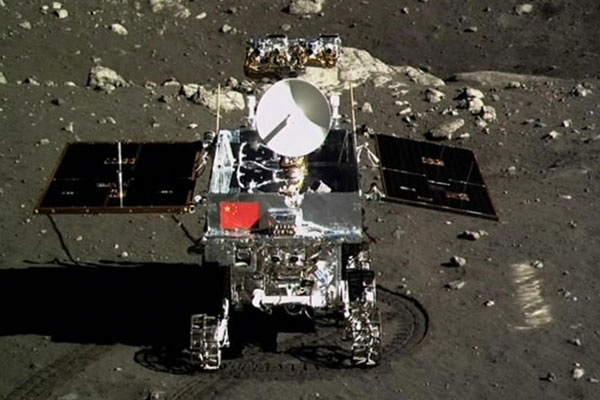China aims to first land on 'dark side' of moon
Updated: 2015-05-20 16:50
(chinadaily.com.cn/Agencies)
|
||||||||
 |
|
The photo of the Yutu moon rover taken by the camera on the Chang'e-3 moon lander during the mutual-photograph process after the successful landing of the moon probe on the moon on Dec 15, 2013. [Photo/Xinhua} |
China is planning to land its Chang'e-4 probe on the moon's "dark side", which has never before been explored, Wu Weiren, the chief engineer for China's Lunar Exploration Program told Chinese Central Television.
"We probably will choose a site on which it is more difficult to land and more technically challenging…Our next move will probably see some spacecraft land on the far side of the moon," Wu said.
The "dark" side of the moon is not actually dark — it receives just as much sunlight as the hemisphere that can be seen from Earth.
The reason that the dark, or far, side of the moon, never faces Earth is a phenomenon known as "tidal locking." Over the course of millions of years the Earth's gravity slowed the moon's rotation, matching it to the speed of its orbit.
The Soviet probe Luna 3 was first to photograph the dark side in 1959 and astronauts on the Apollo 8 mission were the first humans to see it. Since then, it's been photographed by various probes, most recently the Lunar Reconnaissance Orbiter.
China's lunar exploration program, named after the mythological moon goddess Chang'e, is divided into three stages: orbiting, landing and return.
China launched its first lunar probe, Chang'e-1, on Oct 24, 2007, from the southwestern Sichuan province. The probe ended its 16-month mission on March 1, 2009, when it crashed into the moon's surface. The second probe, Chang'e-2, was launched the following year.
Chang'e 3, launched in 2013, marked the completion of the second stage of the country's lunar program. It landed on the moon and was the first spacecraft to do so safely since the Soviet probe Luna 23 in 1976.
Chang'e-4, set to launch in 2020, will orbit the moon before sending a rover to the surface — possibly on the so far unexplored far side for the first time.

 Jetman duo zip across Dubai sky
Jetman duo zip across Dubai sky
 Creativity marks graduation photos
Creativity marks graduation photos
 Ten photos you don't wanna miss - May 20
Ten photos you don't wanna miss - May 20
 In photos: Cities in the clouds
In photos: Cities in the clouds
 Premier Li Keqiang welcomed by Brazilian president
Premier Li Keqiang welcomed by Brazilian president
 Weirdest towns in the world
Weirdest towns in the world
 Students from vocational schools also make big bucks
Students from vocational schools also make big bucks
 Ten photos you don't wanna miss - May 19
Ten photos you don't wanna miss - May 19
Most Viewed
Editor's Picks

|

|

|

|

|

|
Today's Top News
China, Brazil launch new era of economic relations
US should end its 'backyard' zero-sum game
Xiaomi debuts in US, Europe with online store
More than 450 scholars urge Japan to address history issues
Brazil embraces third wave of Chinese investment
Taoist teaches US official one or two things about feng shui
White House bans police from using certain military equipment
China eyes 'capacity exports' to sustain growth
US Weekly

|

|







